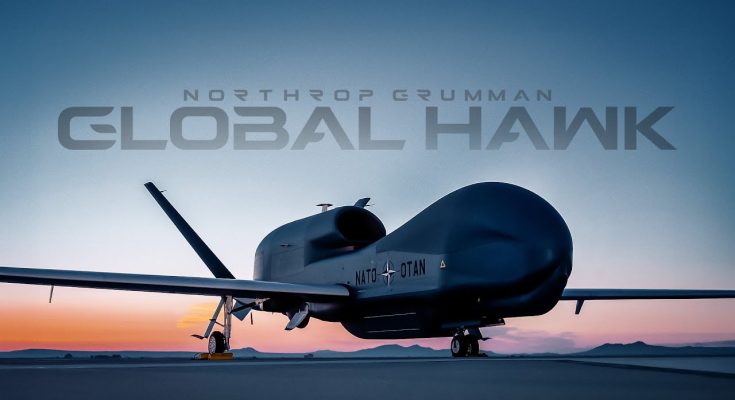The RQ-4 Global Hawk is a highly advanced unmanned aerial vehicle (UAV) developed by Northrop Grumman. Designed for high-altitude, long-endurance surveillance and reconnaissance, the Global Hawk has become a vital asset for military forces around the world, providing critical intelligence, surveillance, and reconnaissance (ISR) capabilities in a variety of operational environments. With its impressive flight range, cutting-edge sensors, and ability to operate in contested airspaces, the RQ-4 has transformed the way intelligence is gathered, ensuring its place as one of the most advanced UAVs in the world.
1. Unmatched Surveillance Range
One of the standout features of the RQ-4 Global Hawk is its incredible range and endurance. The UAV can fly at altitudes of up to 60,000 feet, well above the range of most commercial and military aircraft, allowing it to operate in areas far from potential threats while still delivering high-resolution imagery. The aircraft has an endurance of up to 32 hours, allowing it to continuously survey large areas, whether it’s monitoring a battlefield, gathering intelligence in a contested zone, or conducting disaster response operations.
This long endurance and high-altitude capability mean that the RQ-4 can cover vast areas without needing frequent refueling, making it ideal for surveillance missions that require sustained, persistent observation over extended periods. This ability to loiter in the sky for long durations gives the UAV a distinct advantage over manned aircraft, which typically have shorter operational times and higher risks.
2. Advanced Sensor Technology
The Global Hawk is equipped with state-of-the-art sensors and surveillance systems that allow it to perform a wide variety of missions. Its synthetic aperture radar (SAR) can create detailed images of the ground, even through cloud cover or at night. The UAV is also equipped with electro-optical/infrared (EO/IR) cameras that provide real-time, high-definition video footage for intelligence gathering.
These sensors allow the Global Hawk to detect and track moving targets, map terrain, monitor infrastructure, and identify potential threats. Its sensors are designed to work seamlessly together, creating a complete, real-time picture of the situation on the ground. Additionally, the Global Hawk can transmit this data directly to ground stations or operational commanders, providing immediate intelligence to decision-makers.
3. Low Risk for Personnel
One of the primary benefits of using the RQ-4 Global Hawk is that it significantly reduces the risk to military personnel. Unlike manned aircraft, which can be vulnerable to enemy fire, the UAV can operate in contested areas without putting human lives at risk. This capability makes it a highly effective tool for gathering intelligence in dangerous or hostile environments, such as over enemy territory or during high-intensity conflict.
Furthermore, because it is unmanned, the Global Hawk can be deployed in situations where it might be too risky or impractical to send manned aircraft, such as for surveillance over a hostile region or in the aftermath of natural disasters where human access may be limited.
4. Global Deployability and Versatility
The Global Hawk is highly adaptable and can be deployed for a range of missions beyond military operations. It has been used in humanitarian efforts, disaster relief, and environmental monitoring. The UAV can be tasked with tracking wildfires, conducting oil spill surveillance, monitoring flood areas, and assessing damage in regions affected by natural disasters. Its flexibility allows it to be utilized across a wide array of applications, making it valuable not only for military forces but also for civilian agencies and international organizations.
In addition, the Global Hawk is designed to be interoperable with various NATO and allied forces, allowing for joint missions and cooperation in a coalition setting. This global deployability ensures that the UAV can be integrated into a variety of operations, enhancing its value on the international stage.
5. Strategic Impact on Modern Warfare
The RQ-4 Global Hawk has changed the landscape of modern warfare by providing commanders with a continuous, near-real-time intelligence feed. Its ability to collect battlefield data, monitor troop movements, track vehicle convoys, and conduct signal intelligence (SIGINT) operations is invaluable in shaping the strategic picture of any military conflict.
The aircraft’s persistent surveillance capabilities are especially critical in counterterrorism operations, border security, and maritime domain awareness. By providing uninterrupted monitoring, the Global Hawk can help prevent surprise attacks, improve situational awareness, and support decision-making in real time, thus allowing military forces to maintain the initiative in conflicts.
Conclusion
The RQ-4 Global Hawk represents the cutting edge of unmanned aerial reconnaissance technology, offering unmatched surveillance range, endurance, and intelligence-gathering capabilities. Its combination of advanced sensor systems, long-duration flight, and ability to operate in contested environments makes it an indispensable asset to modern military forces and intelligence agencies around the world. Whether it’s conducting surveillance over hostile territory, aiding in disaster response, or providing critical situational awareness in combat, the Global Hawk has solidified its role as one of the most powerful and versatile UAVs in the world.



